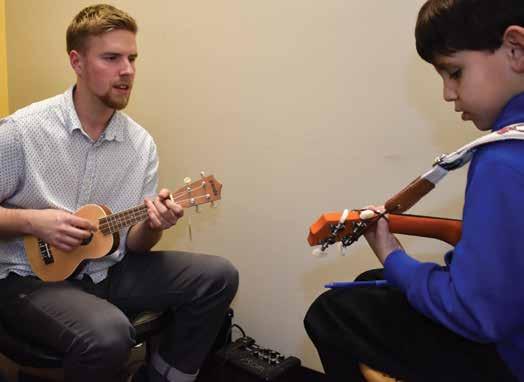
7 minute read
Old-School Sounds
by DYLAN ROCHE photography by SOFIA SCIACCA, FEARLESS PHOTOGRAPHY MENTEE
its niche specialty, or maybe because of it, the store has survived changing cultures and down economies, continuing to be a haven for budding and accomplished musicians alike, a place where the quality of craftsmanship and sound matter, and where old guitars find new life.
Advertisement
Hogue describes Garrett Park Guitars, located today at 7 Old Solomon’s Island Road in Annapolis, as a museum store as much as it is a store; he and his team are less like salespeople and more like curators. “Yeah, it’s a business, but there’s a passion we have, A s a musician and a collector of vintage guitars, Rick Hogue has enjoyed several amazing experiences: partying with Eric Clapton, meeting Bob Dylan, appraising Lenny Kravitz’s guitar collection. He’s jammed with friends and neighbors, bought and sold guitars to local artists, and offered space for music teachers to connect with generations of students. His passion is one of the reasons that Garrett Park Guitars—the shop he established more than 30 years ago—has flourished. Despite
here,” he says. “All of us who work here share in this love for handling, restoring, and selling these old instruments.” Vintage guitars line the walls in several rooms and alcoves, and the staff is poised to discuss the instruments with anyone who walks in off the street, whether it’s a talented and knowledgeable musician or a curious passerby. “Rick was way ahead of the game on the vintage gear thing,” says local musician and longtime patron Bryan Ewald. “I learned quite a bit over the years from him about what was what.”
Rick Hogue, owner of Garrett Park Guitars, in the guitar showroom playing a 1964 reissue Gibson ES-335 guitar.
Garrett Park customers walk past the front desk after a private guitar lesson.
Hogue realized his potential for refurbishing and reselling guitars in the early 1980s, when he searched to buy a 1963 Fender Telecaster. Frustrated that he only had $300 to spend and the guitar he wanted was $550, he settled for a $300 1964 Fender Jaguar. He continued searching for the older guitar and eventually found a refinished one. Upon calling the seller, he found that he could trade the Jaguar for a 1967 Fender Telecaster and a 1966 Fender Bandmaster amp. Because the ’67 Telecaster had been stripped down to its natural wood, he then spray-painted it seafoam green and polished it until it looked new. He sold the guitar for $300 and an amp for $250, and then went back and bought the 1963 Telecaster, which he later sold to a neighbor for $650.
“The lightbulb went off in my head—I thought, ‘I could do this as a hobby,’” he recalls. “For years, it was my side hustle—I had a job in medical sales. I got promoted, became the regional manager, traveled all over the place, and like 60 percent of the time I was doing my day job, but the rest of the time, I was looking for guitars. Back in the day, I would travel down south and fill my car with guitars and amps to bring them back.”
Some locals remember when Hogue started operating more informally. “I met [Rick] before he had a store,” says local musician Dean Rosenthal. “He was going around, selling stuff out of the back of his car . . . he was just kinda getting into it. I remember going to gigs, and Rick would show up. When he opened up his first shop, I started going up there because, at that time, there weren’t a lot of music stores in Annapolis. There really wasn’t a guitar hub with collectors’ guitars, vintage guitars . . . you had to go to DC or Baltimore.” In October 1991, Hogue moved his business into a brick-andmortar storefront in Arnold—he had previously operated out of a neighbor’s downstairs apartment— and named it Garrett Park Guitars because he liked the sound of it.
Colorful ukuleles hang on the wall in the front showroom at Garrett Park Guitars.


Garrett Park Guitars offers a variety of music lessons for all ages. Stefan Heuer, a local musician gives a lesson on the ukulele to nine-year-old Eli. Starting a family made it difficult for Hogue to travel and seek out old guitars, so for several years he focused his business on new models. Although he enjoyed the work and maintained great relationships with the manufacturers, vintage guitars continued to be his first love. “About 10 years ago or a little longer, during the recession, it got hard to sell anything,” he says. “Gradually, I started losing interest in new guitars, and we sort of parted ways with some of these manufacturers that I had worked really hard to get . . . In a way, it was a gift because it focused my attention back to vintage guitars.” Hogue explains that vintage guitars are valuable to musicians because they’re built with craftsmanship that was sacrificed when the instruments became popular in the mid-1960s. “It was a passion shared by millions and millions of people,” he says. “The manufacturers responded by pumping guitars out. Instead of craftsmen dictating how instruments were built, you had accountants, cost evaluation, saying, ‘We can get two necks out of that block of wood if we shave off an eighth of an inch’ or, ‘We can use polyurethane instead of lacquer.’ They were cutting corners in order to increase production and cut costs. They were cutting out central things that made guitars so wonderful in the first place.” And musicians took notice. The new guitars were not as easy to hold or play, and the sound was not quite as good—and thus an interest in vintage guitars began.
Hogue knows that his shop is a beacon for collectors in a market fraught with forgery, and it takes a knowledgeable collector to identify
General Manager Nate Kieser shows the Paul Reed Smith 2002 Dragon Prototype #2.


the real ones. “You have to have confidence to buy one of these old guitars,” he explains. “I’m very fortunate that I learned from others who had great knowledge, and I’ve been mentored by really great people.”
Such expertise and knowledge have built a reputation for Garrett Park Guitars, which is regarded as a place not only where people can buy vintage guitars or get their guitars repaired but also where musicians with specialized interests can be served. “I don’t know anyone else who has the kind of knowledge Rick does, and the passion for it,” says Larry Freed, publisher of Annapolis Music Scene magazine. “Even more important than that, he gets to know each individual who is a buyer of these things . . . it’s not about selling something to a customer. It’s helping friends get what they want.”
Garrett Park Guitars also nurtures the musician beyond sales. In 2004, it launched the Garrett Park School of Music, offering lessons. Since then, it has grown to accommodate about 200 students. “We put kids in bands, and then we teach them their parts, and then they go out and play shows,” says Hogue. “And some of these kids are really, really good. That’s been very rewarding for us to see.” The business is also known for its philanthropy. Ewald notes that Hogue is supportive of area musicians and their causes. For example, he donates instruments for auction at Annapolis Musicians Fund for Musicians (AMFM) fundraisers. It’s also where people can check out the latest find by Hogue or another Annapolis musician—perhaps a concert poster or a suit once worn by George Harrison. “To this day, I still go to Rick’s shop, and he’ll go, ‘Hey, look at this,’ and I’ll go, ‘My God, where did you get that?’” says Rosenthal. “He’ll say, ‘I have my sources.’ It’s unbelievable.” From Hogue’s perspective, Garrett Park Guitars is a way that he, a musician and collector, can support others in a wildly talented community and further an appreciation for music. “Music has been such a passion, such a blessing for me my whole life,” he says. “Music is such a great medicine for us when we’re happy and when we’re sad. It’s just something that touches us in place nothing else can.” █
For more information, visit www.gpguitars.com.











